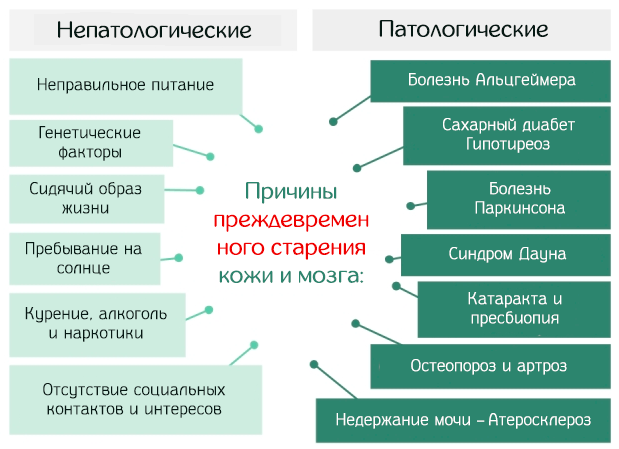
Premature aging is a condition of premature modification of cells due to genetic, behavioral or pathological reasons. This is manifested primarily by loss of skin elasticity and decreased cognitive function.
But what are the reasons that lead to premature aging?
What is premature aging
There is no exact definition of the age at which a person becomes elderly, but, as a rule, this milestone is located around 65 years, the period when most people complete their main work activity.
ABOUT Premature aging is said to occur when changes associated with age begin to appear before this time..
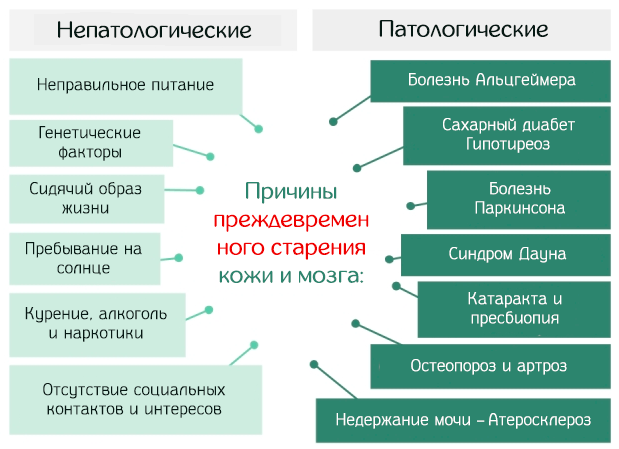
Aging is a natural process that begins at birth and continues throughout life, characterized by a gradual increase in entropy (a function that describes states of equilibrium and disorder in a system) of the complex systems of our body.
Aging is characterized by changes in the qualities of the biological cells that make up the body. More precisely, the number of cells decreases and, at the same time, their functionality decreases.
The biological reasons for this mechanism are related to:
- Deterioration of the protein synthesis mechanism
- Accumulation of errors during DNA copying
Premature aging is a problem that affects 20% of people. Despite the significant increase in average life expectancy, there are just as many factors that can accelerate the physiological aging process, ranging from environmental factors, lifestyle, to the presence of genetic pathology.
Symptoms of aging – manifestations on the skin and brain
The transformations that the human body undergoes with age affect all organs and tissues:
- cardiovascular system: the range of blood flow decreases and the stiffness of the heart muscle increases;
- respiratory system: less oxygen enters the blood;
- immune system: antibody production decreases;
- musculoskeletal system: calcium is washed out from bones, which become more fragile;
- sense organs: presbyopia and hearing problems.
But, among first symptoms of premature aging there are changes in the brain and skin.
Leather becomes thinner, due to the gradual loss of elastin and collagen, muscles lose tone, deep wrinkles appear and the skin begins to sag.
Brain loses some neurons and neural connections with subsequent decreased cognitive function, such as memory and processing ability, changes in behavior.
Causes – genes, behavior and pathological conditions
Many factors can accelerate aging, some of them are associated with pathologies, others are non-pathological in nature.
Factors that do not depend on diseases are:
- genetic factors: Each person's genes may be more or less predisposed to certain diseases;
- environmental factors: some areas of residence carry a greater or lesser risk of disease;
- life style: poor diet, sedentary lifestyle, smoking, alcohol and drugs can damage many organs, which accelerates physiological aging;
- socio-cultural factors: Older people who maintain social contacts or interests keep their brains active, and are less prone to dementia and depression;
- Sun: Responsible for many skin changes due to the negative effects of ultraviolet rays.
Premature aging may be associated with the early onset of diseases characteristic of older people:
- Alzheimer's disease and other dementias: brain changes that cause memory loss and other cognitive dysfunction;
- diabetes: increased glucose levels requiring treatment with insulin;
- osteoporosis and osteoarthritiswhich are associated with the loss of calcium from bones and articular cartilage;
- Parkinson's disease: a degenerative pathology of the brain that causes trembling and difficulty moving;
- urinary incontinence: inability to control urination;
- atherosclerosis and cardiovascular diseases: Hardening of the arteries due to atherosclerotic plaque increases the risk of heart attacks and strokes;
- cataract and presbyopia: clouding of the lens and difficulty focusing on close objects;
- hypothyroidism: Decreased production of thyroid hormones due to anemia, low body temperature and heart failure.
In addition, there is a group rare genetic diseases, which directly lead to unnatural and premature aging:
- Werner's syndrome
- progeria or Hutchinson-Gilford syndrome
- Down syndrome
- Bloom's syndrome
- trichothiodystrophy
- dermopathy
How to prevent premature aging
The way to combat premature aging, if it is not associated with specific diseases, begins with correct lifestyle.
Recent research has shown that proper nutrition, physical activity and reducing oxidative stress increase activity telomerase, an enzyme that lengthens telomeres (the final part of chromosomes), which have the task of preventing the loss of information when chromosomes are copied.
Diet rich in fruits, vegetables and whole grains, low in fat and refined carbohydrates, prevents the accumulation of excess body weight, which is the cause of diseases such as atherosclerosis, cardiovascular disease, diabetes and kidney disease.
Physical exercise not only has a preventive effect against cardiovascular diseases, but also stimulates the restoration of neurons, reducing the risks of neurodegenerative disorders and dementia.
Oxidative stresscaused by free radicals, not only causes many diseases, but also damages cell membranes. Therefore, it is necessary to introduce additional antioxidants through diet, such as polyphenols, as well as vitamins that reduce the effects of free radicals.
Stem cells
Future therapies are likely to be based on stem cells, which are undifferentiated cells and can become any type of specialized cell in the body.
In the future, they could be used to repair or replace damaged tissue.
Gene therapy
Research in gene therapy, that is, the order of transmission of genetic material, is associated mainly with the treatment of Parkinson's and Alzheimer's diseases.

Humanity has not yet learned to fight all illnesses. Progeria, or premature aging syndrome, should also be considered an incurable disease.
What is premature aging syndrome
People started talking about progeria for the first time relatively recently. This is not surprising, because the disease is extremely rare - 1 time in 4-8 million people. The disease occurs at the genetic level. The aging process accelerates approximately 8–10 times. There are no more than 350 examples of the development of progeria in the world.
The disease affects males more than females (1.2:1).
The disease is characterized by severe growth retardation (manifests from an early age), changes in the structure of the skin, absence of hair and secondary sexual characteristics, as well as cachexia (depletion of the body). Internal organs are often not fully developed, and the person looks much older than his actual age.
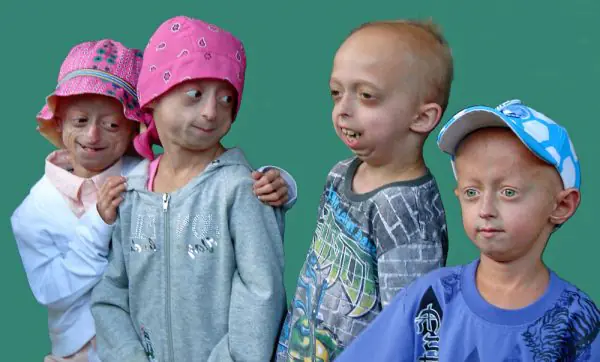
Progeria is a genetic disease that manifests itself as underdevelopment and premature aging of the body.
The mental state of an individual suffering from progeria corresponds to biological age.
Progeria cannot be cured and causes the development of atherosclerosis (chronic artery disease), which ultimately leads to heart attacks and strokes. The result of the pathology is death.
Forms of the disease
Progeria is characterized by premature withering of the body or its underdevelopment. The disease involves:
- childhood form (Hutchinson-Gilford syndrome);
- adult form (Werner's syndrome).
Progeria in children can be congenital, but most often the first signs of the disease appear in the second or third year of life.
Progeria in adults occurs differently. The disease can suddenly overtake an individual at the age of 14–18 years. The prognosis in this case is also unfavorable and leads to death.
Video: progeria, or young old people
Reasons for the development of progeria
The exact causes of progeria have not yet been discovered. There is an assumption that the etiology of the development of the disease is directly related to the disruption of metabolic processes in connective tissue. Fibroblasts begin to grow through cell division and the appearance of excess collagen with low glycosaminoglycan levels. Slow formation of fibroblasts is an indicator of the pathology of intercellular matter.
Causes of progeria in children
The cause of the development of progeria syndrome in children is changes in the LMNA gene. It is he who is responsible for encoding lamin A. We are talking about a human protein from which one of the layers of the cell nucleus is created.
Often progeria is expressed sporadically (randomly). Sometimes the disease is observed in siblings (descendants from the same parents), especially in blood-related marriages. This fact indicates a potential autosomal recessive form of inheritance (manifests exclusively in homozygotes who received one recessive gene from each parent).
When studying the skin of carriers of the disease, cells were recorded in which the ability to correct damage in DNA was impaired, as well as to reproduce genetically homogeneous fibroblasts and change the depleted dermis. As a result, subcutaneous tissue tends to disappear without a trace.
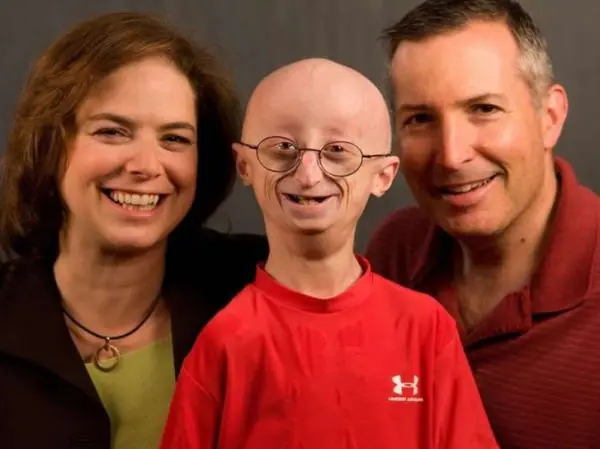
Progeria is not inherited
It has also been recorded that the Hutchinson-Gilford syndrome being studied is related to pathologies in carrier cells. The latter are simply unable to fully free themselves from DNA compounds caused by chemical agents. When cells with the described syndrome were detected, experts determined that they were not capable of full division.
There are also suggestions that childhood progeria is an autosomal dominant mutation that occurs de novo, or without signs of inheritance. It was considered one of the indirect signs of the development of the disease, the basis of which included measurements of telomeres (the ends of chromosomes) in the owners of the syndrome, their close relatives and donors. In this case, an autosomal recessive form of inheritance is also seen. There is a theory that the process provokes a violation of DNA repair (the ability of cells to correct chemical damage, as well as breaks in molecules).
Reasons for the formation of progeria in adults
Progeria in an adult organism is characterized by autosomal recessive inheritance with the mutation gene ATP-dependent helicase or WRN. There is a hypothesis that in the unifying chain there are failures between DNA repair and metabolic processes in the connective tissue.
Since this form of the disease is extremely rare, one can only guess what type of inheritance is inherent in it. It is similar to Cockayne syndrome (a rare neurodegenerative disorder characterized by growth failure, disorders in the development of the central nervous system, premature aging and other symptoms) and manifests itself as separate signs of early aging.
Symptoms of early aging of the body
The symptoms of progeria manifest themselves in a complex manner. The disease can be recognized at an early stage, since its symptoms are clearly expressed.
Symptoms of early aging disease in children
At birth, children who have the deadly progeria gene cannot be distinguished from healthy babies. However, by the age of 1 year, certain symptoms of the disease manifest themselves. These include:
- underweight, stunted growth;
- lack of hair on the body, including on the face;
- lack of subcutaneous fat reserves;
- insufficient tone in the skin, causing it to sag and become wrinkled;
- bluish skin tone;
- increased pigmentation;
- strongly visible veins in the head area;
- disproportionate development of the bone tissue of the skull, small lower jaw, bulging eyes, prominent ear shells, hooked nose. A child with progeria typically has a “bird-like” grimace. It is the described list of peculiar characteristics that makes children look like older people;
- late teething, which lose their healthy appearance in a short time;
- shrill and high-pitched voice;
- a pear-shaped chest, small collarbones, tight knee joints, as well as elbow joints, which, due to insufficient mobility, force the patient to take the “rider” position;
- protruding or convex yellow nails;
- scleral-like formations or thickening on the skin of the buttocks, thighs and lower abdomen.
When a small patient suffering from progeria turns 5 years old, inexorable processes of atherosclerosis formation begin to occur in his body, in which the aorta, mesenteric, and coronary arteries are severely affected. Against the background of the described failures, heart murmurs and hypertrophy (a significant increase in the mass and volume of the organ) appear in the left ventricle. The cumulative impact of these serious disorders in the body is a key reason for the low life expectancy of carriers of the syndrome. The fundamental factor that provokes the rapid death of children with progeria is considered to be myocardial infarction or ischemic stroke.
Symptoms of early aging in adults
A progeria carrier begins to quickly lose weight, be stunted in growth, turn gray and soon go bald. The patient's skin becomes thin and loses its healthy tone. Blood vessels and subcutaneous fat are clearly visible under the surface of the epidermis. With this disease, the muscles atrophy almost completely, as a result of which the legs and arms look excessively exhausted.

Progeria in adults occurs unexpectedly and develops quickly
In patients who have crossed the age limit of 30 years, both eyes are destroyed by cataracts (clouding of the lens), the voice becomes noticeably weaker, the skin over the bone tissue loses its softness, and then becomes covered with ulcerative lesions. Carriers of progeria syndrome are usually similar in appearance. They are distinguished:
- small height;
- moon-shaped face type;
- "bird" nose;
- thin lips;
- a very prominent chin;
- a strong, well-built body and dry, thin limbs, which are disfigured by generously manifested pigmentation.
The disease is unceremonious and interferes with the functioning of all body systems:
- the activity of the sweat and sebaceous glands is disrupted;
- the normal function of the cardiovascular system is distorted;
- calcification occurs;
- Osteoporosis (decreased bone density) and erosive osteoarthritis (irreversible processes in the joints) appear.
Unlike the child form, the adult form also has a detrimental effect on mental abilities.
Approximately 10% of patients by the age of 40 come into contact with such serious illnesses as sarcoma (malignant tissue formation), breast cancer, as well as astrocytoma (brain tumor) and melanoma (skin cancer). Oncology progresses due to high blood sugar and malfunctions of the parathyroid glands. The key causes of death in adults with progeria are most often cancer or cardiovascular abnormalities.
Diagnostics
The external signs of the disease are so obvious and vivid that the syndrome is diagnosed based on the clinical picture.
The disease can be detected even before the baby is born. This became possible thanks to the discovery of the progeria gene. However, since the disease is not transmitted through generations (it is a sporadic or single mutation), the likelihood that two children with this rare disease will be born within the same family is extremely low. After the progeria gene was discovered, detection of the syndrome became much faster and more accurate.
Changes at the gene level are now identifiable. Special programs, or electronic diagnostic tests, have been created. At the moment, it is quite possible to prove and substantiate individual mutational formations in the gene, which subsequently lead to progeria.
Science is developing rapidly, and scientists are already working on the final scientific method for diagnosing progeria in children. The described development will contribute to even earlier and more accurate diagnosis. Today, in medical institutions, children with this diagnosis are examined exclusively externally, and then tests and a blood sample are taken for testing.
If symptoms of progeria are detected, you must urgently seek advice from an endocrinologist and undergo a comprehensive examination.
Treatment of progeria
To date, no effective treatment for progeria has been found. The therapy is characterized by a symptomatic line, with the prevention of consequences and complications resulting from the progress of atherosclerosis, diabetes mellitus and ulcerative formations. For an anabolic effect (accelerating the process of cell renewal), a somatotropic hormone is prescribed, which is designed to increase weight and body length in patients. The therapeutic course is carried out by several specialists at once, such as an endocrinologist, cardiologist, therapist, oncologist, and others, based on the symptoms prevailing at a particular moment.
In 2006, scientists from America recorded clear progress in the fight against progeria as an untreatable disease. The researchers added a farnesyltransferase inhibitor (a substance that suppresses or delays the course of physiological or physicochemical processes), which had previously been tested on cancer patients, to the culture of mutating fibroblasts. As a result of the procedure, the mutation cells acquired their usual shape. The carriers of the disease tolerated the created drug well, so there is hope that in the near future it will become possible to use the drug in practice. In this way, it will be possible to exclude progeria at an early age. The effectiveness of Lonafarnib (a farnesyltransferase inhibitor) lies in the increase in the amount of subcutaneous fat in total body weight, as well as bone mineralization. The result is to reduce the number of injuries to a minimum.
There is an opinion that similar remedies can help in curing the disease as in the fight against cancer. But these are only assumptions and hypotheses, not confirmed by facts.
Therapy for patients today comes down to:
- providing ongoing continuity of care;
- special diet;
- cardiac care;
- physical support.
For progeria, treatment is exclusively supportive in nature and is focused on correcting changes occurring in the patient’s tissues or organs. The methods used are not always effective. However, doctors are doing everything they can. Patients are under continuous supervision by medical professionals.
Only by monitoring the function of the cardiovascular system is it possible to timely diagnose the development of complications and prevent their progress. All treatment methods are focused around a single goal - to stop the disease and not give it a chance to worsen, as well as to alleviate the general condition of the carrier of the syndrome, as far as the potential of modern medicine allows.
Treatment may include the following:
- use of Aspirin in a minimal dosage, which can reduce the risk of developing a heart attack or stroke;
- the use of other medications that are prescribed to the patient privately based on the presenting symptoms and his well-being. For example, drugs from the statin group reduce the amount of cholesterol in the blood, and anticoagulants prevent the formation of blood clots. A hormone that can increase height and weight is often used;
- the use of physical therapy or procedures designed to work out joints that are difficult to bend, thereby allowing the patient to maintain activity;
- elimination of milk teeth. A peculiar feature of the disease contributes to the premature appearance of molars in children, while milk teeth must be removed on time.
Based on the fact that progeria is genetic or random in nature, there are no preventive measures as such.
Treatment prognosis
The prognosis for carriers of progeria syndrome is unfavorable. Average indicators say that patients most often survive only up to 13 years, subsequently dying from hemorrhages or heart attacks, malignant neoplasms or atherosclerotic complications.
Progeria is incurable. The therapy is only in development. There is no definitive evidence of a cure yet. However, medicine is developing rapidly, so there is a high probability that patients with progeria will have a chance for a normal and long life.
The process of premature modification of cells due to exposure to pathological, genetic or external factors is called premature aging disease. The pathology is poorly understood, and the exact causes of the development of this condition have not been identified. There are a number of external and internal factors that provoke the disease. According to statistics, rapid aging syndrome is extremely rare (there is 1 sick person per 4 million people).
What Causes Early Aging
Premature aging syndrome is a condition when age-related physiological changes occur in a person much earlier than expected. Aging is a natural process, characterized by a gradual decrease in entropy (life processes) of all body systems. In addition, changes occur in various cell qualities: the protein synthesis mechanism is disrupted and errors gradually accumulate when copying DNA.
Among the first signs of premature aging are changes in the skin (deep wrinkles appear, the skin becomes thinner, and begins to sag) due to disruption of the synthesis of elastane and collagen. Changes in the functioning of the brain are noted: due to the fact that functional cells (neurons) are destroyed, a person’s cognitive abilities (for example, memory) significantly deteriorate. In addition, Werner syndrome is characterized by the following disorders of the body systems:
- Cardiovascular: destruction of blood vessels occurs, the volume of cardiac output decreases, the heart muscle thickens, loses elasticity and ability to regenerate, and atherosclerosis develops.
- Immune: antibody production decreases.
- Musculoskeletal system: rapid muscle atrophy, development of osteoporosis, arthritis.
- Sense organs: presbyopia develops (age-related decrease in visual acuity), hearing loss, cataracts, and complete hearing loss.
- Reproductive system: women experience early menopause, men suffer from erectile dysfunction, and the likelihood of developing malignant tumors increases.
Causes
Many factors of a pathological or physiological nature can accelerate the aging process. Among the reasons not related to diseases are the following:
- genetic predisposition;
- environmental factors;
- Lifestyle;
- climate.
Premature aging can be triggered by the early manifestation of systemic diseases. In this case, the syndrome usually manifests itself in early childhood, adolescence or young adulthood. Among the pathological causes leading to early aging are:
- Alzheimer's disease;
- diabetes;
- osteoporosis, osteoarthritis;
- Parkinson's disease;
- cardiovascular pathologies;
- hypothyroidism;
- Down syndrome;
- trichothiodystrophy;
- dermopathy.

What is premature aging disease
The pathological process, which is provoked by premature aging and is characterized by changes in the condition of the skin, disruption of the functioning of organs and systems, is called progeria. Mental development is assessed as satisfactory. There are two types of the disease: childhood (Hutchinson-Gilford syndrome) and adult (Werner syndrome). Presumably, the pathology in adults has an autosomal recessive type of inheritance, and in children it occurs spontaneously.
Causes
It is known that rapid aging disease is a pathology of genetic origin and occurs due to mutation of the LMNA gene, which encodes the synthesis of lamins - proteins that are part of the cell nucleus shell. Genetic disorders provoke instability of cellular structures, which leads to the rapid launch of aging mechanisms. A large number of proteins are deposited (accumulated) in cells, which lose the ability to divide, renew themselves and die prematurely.
In addition, the mutation provokes the production of a truncated, unstable progerin protein, which quickly degrades. It does not penetrate into the core shell plate located under the membrane, as a result of which it collapses. This process is key in the pathogenesis of progeria. The disease occurs in children of the same parents (siblings) or in the offspring of consanguineous marriages. When studying the cells of people suffering from this disease, gross violations of DNA repair in cells and the synthesis of fibroblasts were discovered. The childhood form of progeria is considered congenital.
Symptoms
The clinical picture of premature aging disease manifests itself over time. With Hutchinson-Gilford syndrome, the first symptoms of the pathology appear at 2-3 years of life, and with Werner syndrome, as a rule, within six months after puberty. The disease affects the entire body at once, disrupting the functioning of almost all vital organs.
In childhood
Progeria occurring in childhood is characterized by a sharp slowdown in the child’s growth, atrophy of the dermis, subcutaneous tissue, and loss of skin elasticity. The epidermis becomes thinner, becomes dry and wrinkled, scleroderma-like lesions and hyperpigmentation are noted on the body. Large and small veins are visible through the pale and thinned skin. In addition, the following signs of Hutchinson-Gilford syndrome are noted:
- skeletal muscle atrophy;
- fragility of teeth;
- brittleness of hair and nails;
- pathological changes in the musculoskeletal system, myocardium;
- underdevelopment of the genital organs;
- disorders of fat metabolism;
- cataract;
- atherosclerosis.
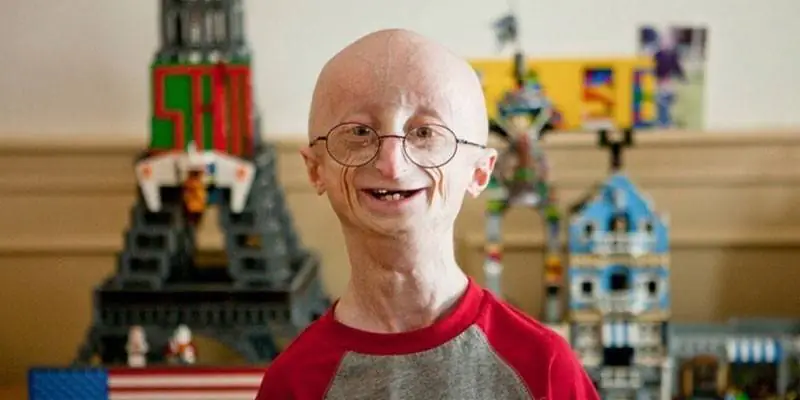
Due to the fact that the disease affects all cells of the body and changes their qualitative structure, all human tissues and organs change greatly. People who suffer from progeria have some specific appearance features:
- a large head with prominent large frontal tubercles that protrude above the small “bird-like” face;
- the lower jaw is greatly underdeveloped;
- beak-shaped nose;
- there are no secondary sexual characteristics;
- height about 90-130 cm;
- limbs thin, short.
In adults
The first clinical symptoms of the disease in adults appear by the age of 14-18 years. Before puberty, no signs of premature aging disease are observed. Patients begin to lag behind in physical development, turn gray and go bald. The skin quickly becomes thinner, becomes pale and has pigment spots. The limbs look very thin due to atrophic changes in the subcutaneous tissue and muscles. By the age of 30, patients develop the following signs of the disease:
- cataract;
- trophic ulcers;
- dysfunction of the sweat and sebaceous glands;
- arthritis;
- exophthalmos;
- moon-shaped face;
- sexual dysfunction.
Treatment
There is no specific therapy for the syndrome and disease of premature aging. Treatment is aimed at maintaining the patient’s condition and maintaining metabolic processes. Complex therapy for progeria includes:
- Constantly taking small doses of Aspirin, which prevent strokes and heart attacks.
- Prescription of other groups of medications (statins, hormonal drugs, etc.) that regulate cholesterol levels, blood sugar and support metabolism, oxygen in tissues.
- Physiotherapeutic procedures that maintain and restore physical activity.

Forecast
Both adult and childhood progeria are fatal in 100% of cases. As a rule, death occurs as a result of stroke, heart attack or multiple organ failure. The life expectancy of people with progeria is approximately 11-13 years (in children) and 35-40 years (in adults). Patients suffering from premature aging disease constantly need medical supervision.



